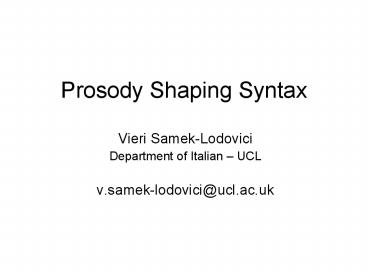Prosody Shaping Syntax PowerPoint PPT Presentation
1 / 30
Title: Prosody Shaping Syntax
1
Prosody Shaping Syntax
- Vieri Samek-Lodovici
- Department of Italian UCL
- v.samek-lodovici_at_ucl.ac.uk
2
Cognitive Architecture
- OT (Prince Smolensky 93) provides a model of
constraint interaction. - OT is not specific to any particular component
(i.e. not specific to Phonology). - Do distinct components share OT as their
underlying cognitive architecture? - Evidence from the prosody-syntax interface.
3
Focus
- Given a question, the constituent that provides
the requested information in an answer counts as
focused. - Q Who called?
- A MARYF called.
4
Clause-wide Focus
- Q What happened?
- A Maria ha messo un libro sul TAVOLOF Mary
has put a book on-the table - Properties rightmost stress,
- word order S V O IO
5
Narrow Focus
- Q Who has called?
- A Ha telefonato GIANNIF has called
John - Q What has Mary put on the table?
- A Maria ha messo sul tavolo un LIBROF Mary
has put on-the table a book - Properties invariant prosody, altered order.
6
Zubizarreta (1995, 1998)
- Focus is rightmost because focus is stressed, and
main stress is rightmost in Italian. - Position of focus not stipulated unlike
structural accounts.(Antinucci Cinque 77,
Calabrese 82, 92, Belletti Schlonsky 95,
Samek-Lodovici 96) - Conflict best syntactic position for focused
constituent ? best position stress-wise.
7
Problematic Aspects
- Syntax assumed to feed phonology, forcing
syntactic theory of stress against the evidence
supporting its prosodic nature. - Language specific stress rules necessary to
account for cross-linguistic variation.
8
Focus
- Stress-Focus focus carries the highest
prosodic prominence in its - domain.
- See Jackendoff (1972), Truckenbrodt (1995),
Zubizarreta (1998).
9
Prosody
- Head-P align head with right boundary of P.
- Head-I align head with right boundary of I.
- ( x ) I
- ( x ) ( x )( x ) P
- John has put a book on the table F
- See Prince (1983), Selkirk (1984, 1986, 1995),
Nespor Vogel (1986, 1989), Halle Vergnaud
(1987), Hayes (1995), Truckenbrodt (1995, 1999),
Ladd (1996).
10
Syntax
- EPP realize spec-TP (realize preverbal subject).
- Stay dont move.
- See Chomsky (1982, 1992, 1995), Grimshaw (1997).
11
Clause-wide Focus
- Stress-Focus satisfied independently of syntactic
and prosodic arrangements. - No conflict between prosody and syntax.
12
Clause-wide focus EPPgtgtStay
13
Clause-wide focus EPPgtgtStay
14
Narrow Focus
- Stress-Focus ties stress and the focused
constituent together. - Head-I and Head-P push stress and the associated
constituent rightmost. - EPP and Stay require the constituent and the
associated stress elsewhere. - Conflict systematically solved in favor of
prosody.
15
Italian focused subjects Head-IgtgtEPP
16
Italian focused subjects Head-IgtgtEPP
17
Italian focused objects Head-IgtgtStay
18
Italian focused objects Head-IgtgtStay
19
Possible Conflict Resolutions
- Head-I gtgt EPP gtgt Stay ? Italian
- EPP gtgt Stay gtgt Head-I
- EPP gtgt Head-I gtgt Stay
20
Possible Conflict Resolutions
- Head-I gtgt EPP gtgt Stay ? Italian
- EPP gtgt Stay gtgt Head-I ? English
- EPP gtgt Head-I gtgt Stay ? French
21
Crosslinguistic Convergence on Clause-wide Focus
- Prosody-syntax conflict absent.
- Italian Gianni ha messo un libro sul TAVOLOF
John has put a book on-the
table - English John has put a book on the TABLEF
- French Jean a mis un livre sur la TABLEF
John has put a book on the table
22
English rigid syntax, flexible prosody
- ( x ) I
- ( x ) ( x ) P
- JOHNF has called
- ( x ) I
- ( x ) ( x ) ( x ) P
- John has put FLOWERSF on the table
23
English focused subjects EPPgtgtHead-I
24
English focused subjects EPPgtgtHead-I
25
English focused objects StaygtgtHead-I
26
English focused objects StaygtgtHead-I
27
French hybrid system
- ( x ) I
- ( x ) ( x )P
- FLORENCEF a gagné
- Florence has won
- ( x ) I
- ( x ) ( x ) ( x ) P
- Jean a rendu à Marie son LIVREF
- John has returned to Mary her book
28
French focused subjects EPPgtgtHead-I
29
French focused objects Head-IgtgtStay
30
Optimality Analysis
- Crosslinguistic focus analysis that keeps stress
prosodic and lacks language-specific
stipulations. - Domain and range of crosslinguistic variation
dictated by universal constraints
themselvesDomain where constraints
conflict.Range in the forms required by the
constraints. - OT as underlying cognitive architecture shared
across syntax and prosody (see also Szendröi,
Dehé, Truckenbrodt, Büring, Guttierez-bravo).

